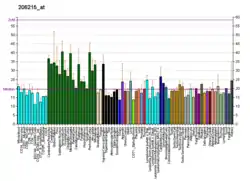OPCML
Opioid-binding protein/cell adhesion molecule is a protein that in humans is encoded by the OPCML gene.[5][6]
| OPCML | |||||||||||||||||||||||||||||||||||||||||||||||||||
|---|---|---|---|---|---|---|---|---|---|---|---|---|---|---|---|---|---|---|---|---|---|---|---|---|---|---|---|---|---|---|---|---|---|---|---|---|---|---|---|---|---|---|---|---|---|---|---|---|---|---|---|
| Identifiers | |||||||||||||||||||||||||||||||||||||||||||||||||||
| Aliases | OPCML, IGLON1, OBCAM, OPCM, opioid binding protein/cell adhesion molecule-like, opioid binding protein/cell adhesion molecule like | ||||||||||||||||||||||||||||||||||||||||||||||||||
| External IDs | OMIM: 600632 MGI: 97397 HomoloGene: 55663 GeneCards: OPCML | ||||||||||||||||||||||||||||||||||||||||||||||||||
| |||||||||||||||||||||||||||||||||||||||||||||||||||
| |||||||||||||||||||||||||||||||||||||||||||||||||||
| |||||||||||||||||||||||||||||||||||||||||||||||||||
| |||||||||||||||||||||||||||||||||||||||||||||||||||
| |||||||||||||||||||||||||||||||||||||||||||||||||||
| Wikidata | |||||||||||||||||||||||||||||||||||||||||||||||||||
| |||||||||||||||||||||||||||||||||||||||||||||||||||
This gene encodes a member of the IgLON subfamily in the immunoglobulin protein superfamily. The encoded protein is localized in the cell membrane and may have an accessory role in opioid receptor function. This gene has an ortholog in rat and bovine. The opioid binding-cell adhesion molecule encoded by the rat gene binds opioid alkaloids in the presence of acidic lipids, exhibits selectivity for mu ligands and acts as a GPI-anchored protein. Since the encoded protein is highly conserved in species during evolution, it may have a fundamental role in mammalian systems. Two transcript variants encoding different isoforms have been found for this gene.[6]
References
- GRCh38: Ensembl release 89: ENSG00000183715 - Ensembl, May 2017
- GRCm38: Ensembl release 89: ENSMUSG00000062257 - Ensembl, May 2017
- "Human PubMed Reference:". National Center for Biotechnology Information, U.S. National Library of Medicine.
- "Mouse PubMed Reference:". National Center for Biotechnology Information, U.S. National Library of Medicine.
- Smith MW, Clark SP, Hutchinson JS, Wei YH, Churukian AC, Daniels LB, Diggle KL, Gen MW, Romo AJ, Lin Y, et al. (Dec 1993). "A sequence-tagged site map of human chromosome 11". Genomics. 17 (3): 699–725. doi:10.1006/geno.1993.1392. PMID 8244387.
- "Entrez Gene: OPCML opioid binding protein/cell adhesion molecule-like".
Further reading
- Lane CM, Elde R, Loh HH, Lee NM (1993). "Regulation of an opioid-binding protein in NG108-15 cells parallels regulation of delta-opioid receptors". Proc. Natl. Acad. Sci. U.S.A. 89 (23): 11234–8. doi:10.1073/pnas.89.23.11234. PMC 50524. PMID 1333602.
- Shark KB, Lee NM (1995). "Cloning, sequencing and localization to chromosome 11 of a cDNA encoding a human opioid-binding cell adhesion molecule (OBCAM)". Gene. 155 (2): 213–7. doi:10.1016/0378-1119(94)00830-L. PMID 7721093.
- Struyk AF, Canoll PD, Wolfgang MJ, et al. (1995). "Cloning of neurotrimin defines a new subfamily of differentially expressed neural cell adhesion molecules". J. Neurosci. 15 (3 Pt 2): 2141–56. doi:10.1523/JNEUROSCI.15-03-02141.1995. PMC 6578143. PMID 7891157.
- Andersson B, Wentland MA, Ricafrente JY, et al. (1996). "A "double adaptor" method for improved shotgun library construction". Anal. Biochem. 236 (1): 107–13. doi:10.1006/abio.1996.0138. PMID 8619474.
- Yu W, Andersson B, Worley KC, et al. (1997). "Large-scale concatenation cDNA sequencing". Genome Res. 7 (4): 353–8. doi:10.1101/gr.7.4.353. PMC 139146. PMID 9110174.
- Strausberg RL, Feingold EA, Grouse LH, et al. (2003). "Generation and initial analysis of more than 15,000 full-length human and mouse cDNA sequences". Proc. Natl. Acad. Sci. U.S.A. 99 (26): 16899–903. Bibcode:2002PNAS...9916899M. doi:10.1073/pnas.242603899. PMC 139241. PMID 12477932.
- Sellar GC, Watt KP, Rabiasz GJ, et al. (2003). "OPCML at 11q25 is epigenetically inactivated and has tumor-suppressor function in epithelial ovarian cancer". Nat. Genet. 34 (3): 337–43. doi:10.1038/ng1183. PMID 12819783. S2CID 24411276.
- Ota T, Suzuki Y, Nishikawa T, et al. (2004). "Complete sequencing and characterization of 21,243 full-length human cDNAs". Nat. Genet. 36 (1): 40–5. doi:10.1038/ng1285. PMID 14702039.
- Schmitt-Ulms G, Hansen K, Liu J, et al. (2005). "Time-controlled transcardiac perfusion cross-linking for the study of protein interactions in complex tissues". Nat. Biotechnol. 22 (6): 724–31. doi:10.1038/nbt969. PMID 15146195. S2CID 36630738.
- Gerhard DS, Wagner L, Feingold EA, et al. (2004). "The status, quality, and expansion of the NIH full-length cDNA project: the Mammalian Gene Collection (MGC)". Genome Res. 14 (10B): 2121–7. doi:10.1101/gr.2596504. PMC 528928. PMID 15489334.
- Mei FC, Young TW, Liu J, Cheng X (2006). "RAS-mediated epigenetic inactivation of OPCML in oncogenic transformation of human ovarian surface epithelial cells". FASEB J. 20 (3): 497–9. doi:10.1096/fj.05-4586fje. PMID 16384911. S2CID 24792515.
- Wang L, Zhu JS, Song MQ, et al. (2007). "Comparison of gene expression profiles between primary tumor and metastatic lesions in gastric cancer patients using laser microdissection and cDNA microarray". World J. Gastroenterol. 12 (43): 6949–54. doi:10.3748/wjg.v12.i43.6949. PMC 4087337. PMID 17109515.
- Czekierdowski A, Czekierdowska S, Szymanski M, et al. (2007). "Opioid-binding protein/cell adhesion molecule-like (OPCML) gene and promoter methylation status in women with ovarian cancer". Neuro Endocrinol. Lett. 27 (5): 609–13. PMID 17159813.
- Reed JE, Dunn JR, du Plessis DG, et al. (2007). "Expression of cellular adhesion molecule 'OPCML' is down-regulated in gliomas and other brain tumours". Neuropathol. Appl. Neurobiol. 33 (1): 77–85. doi:10.1111/j.1365-2990.2006.00786.x. PMID 17239010. S2CID 22479211.




